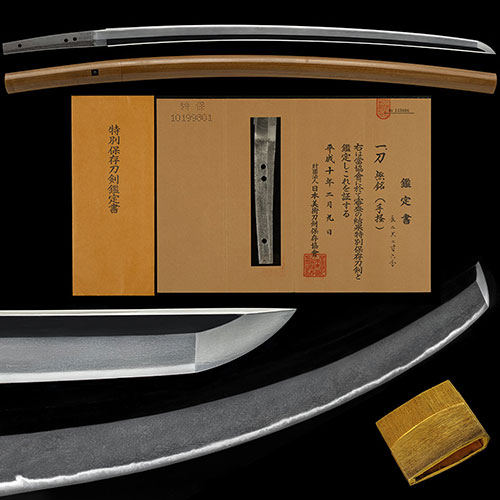
手掻 刀 Tegai Katana
No.305437手掻 鎌倉後期 重要候補 美しい地鉄に金筋幾重にも頻りに掛り地刃冴え渡る健全傑作刀 二尺二寸六分Tegai Late Kamakura period, Juyo candidate Kinsuji entered frequently with beautiful Jigane, Jiba is clear, Kenzen, a sound and excellent sword, 68.4cm
ご成約Sold
- 極めKiwame
- 手掻Tegai
- 登録証Registration
- 大阪府 Osaka 昭和56年9月29日 9/29/56(Showa)
- 時代Period
- 鎌倉後期Late Kamakura period
- 法量Size
-
刃長 68.4cm ( 二尺二寸六分) 反り 1.6cm
元幅 3.2cm 先幅 2.1cm 元重 0.60cm 鎬厚 0.75cm 先重 0.50cm 鋒長 3.4cm 茎長 18.5cmHachou 68.4cm ( 二尺二寸六分) Sori 1.6cm
Moto-Haba 3.2cm Saki-Haba 2.1cm Moto-Kasane 0.60cm Shinogi-Thikess 0.75cm Saki-Kasane 0.50cm Kissaki-Chou 3.4cm Nakago-Chou 18.5cm - 国Country
- 大和Yamato
- 姿Shape
- 鎬造、庵棟、身幅広く、鎬高く、反り尋常、腰反り付き、中鋒。Shinogidukuri, Iorimune, Wide Mihaba, High Shinogi, Standard Sori, Koshizori-tsuki, Chu-Kissaki.
- 鍛Kitae
- 板目肌に、小杢目肌交じり、刃寄り棟寄り柾掛かり、地沸微塵に厚くつき、地景よく入り、淡く映り立ち、鉄冴える。Itamehada, Mixed small-Mokumehada, Hayori-Muneyori-Masagakari, Jinie entered thick and fine, Chikei entered frequently, Faintly Utsuritachi, Iron is clear.
- 刃文Hamon
- 細直刃に、ほつれ・食違い頻りに掛り、小足・葉頻りに入り、小沸よくつき、金筋細かく幾重にも頻りに掛り、匂口明るく冴える。Hoso-Suguha, Hotsure, Kuichigai-shikirinikakari, Small-Ashi and You entered frequently, Small-Nie entered well, frequent fine and multiple layers of Kinsuji, Nioikuchi is bright and clear.
- 帽子Boushi
- 浅くのたれて焼き詰めごころ。Shallow Notarete-Yakitsumegokoro
- 茎Nakago
- 大磨上、先切、鑢目切、目釘孔三。Ohsuriage, Sakikiri, Yasurimegiri, Mekugiana are three(3)
- ハバキHabaki
- 金色絵二重。Double Kiniroe
- 説明Drscription
- 手掻派は東大寺に隷属した刀工集団で、東大寺転害門の門前に住していたことから、手掻(てがい)と呼称されるようになった。鎌倉中期正応(1288)頃の包永を祖とすると伝え、正宗十哲の兼氏も手掻派に属したといわれている。この刀は、身幅広く3.2cmあり、腰反りつき、中鋒となる鎌倉後期の姿で、小杢目肌に、地沸微塵に厚くつき、地景細かく頻りに入る美しい地鉄に、直刃調に、ほつれ・食い違い頻りに掛り、金筋幾重にも頻りに掛るなど刃中盛んに働き、地刃冴え渡る頗る健全な傑作刀である。The Tegai faction is a group of swordsmiths who were enslaved to Todaiji Temple, and since they lived in front of the Todaiji Temple's Tegai Gate, they came to be called Tegai. It is said that Masamune Jittetsu's Kaneuji also belonged to the Tegai faction, saying that he was the ancestor of Kanenaga around the middle of the Kamakura period (1288).
This sword has Wide Mihaba 3..2cm, Koshizori-tsuki, It has the appearance of the late Kamakura period, known as Chu-Kissaki, Small-Mokumehada, Jinie entered fine and thick, Chikei entered finely and frequently with beautiful Jigane, Suguha-style, Hotsure, Kuichigai-shikirinikakari, Kinsuji hangs over and over, it works well in sword, It is an extremely Kenzezn masterpiece with a clear Jiba.


